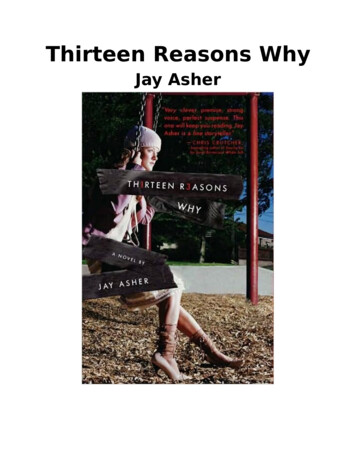
Transcription
VIKINGPublished by the Penguin GroupPenguin Group (USA) LLC375 Hudson StreetNew York, New York 10014USA Canada UK Ireland Australia New Zealand India South Africa Chinapenguin.comA Penguin Random House CompanyFirst published by Viking Penguin, a member of Penguin Group (USA) LLC, 2014Copyright 2014 by Bessel van der KolkPenguin supports copyright. Copyright fuels creativity, encourages diverse voices, promotes freespeech, and creates a vibrant culture. Thank you for buying an authorized edition of this book and forcomplying with copyright laws by not reproducing, scanning, or distributing any part of it in anyform without permission. You are supporting writers and allowing Penguin to continue to publishbooks for every reader.LIBRARY OF CONGRESS CATALOGING-IN-PUBLICATION DATA[Van der Kolk, Bessel A., 1943- author.The body keeps the score : brain, mind, and body in the healing of trauma / Bessel A. van der Kolk.p. ; cm.Includes bibliographical references and index.eBook ISBN 978-1-101-60830-2I. Title.[DNLM: 1. Stress Disorders, Post-Traumatic—physiopathology. 2. Stress Disorders, Post-Traumatic—therapy.WM r the publisher nor the author is engaged in rendering professional advice or services to theindividual reader. The ideas, procedures, and suggestions contained in this book are not intended as asubstitute for consulting with your physician. All matters regarding your health require medicalsupervision. Neither the author nor the publisher shall be liable or responsible for any loss or damageallegedly arising from any information or suggestion in this book.Version 1
To my patients, who kept the score and were the textbook.
CONTENTSPraise for The Body Keeps the ScoreTitle PageCopyrightDedicationPROLOGUE: FACING TRAUMAPART ONE:THE REDISCOVERY OF TRAUMA1. LESSONS FROM VIETNAM VETERANS2. REVOLUTIONS IN UNDERSTANDING MIND AND BRAIN3. LOOKING INTO THE BRAIN: THE NEUROSCIENCE REVOLUTIONPART TWO:THIS IS YOUR BRAIN ON TRAUMA4. RUNNING FOR YOUR LIFE: THE ANATOMY OF SURVIVAL5. BODY-BRAIN CONNECTIONS6. LOSING YOUR BODY, LOSING YOUR SELFPART THREE:THE MINDS OF CHILDREN7. GETTING ON THE SAME WAVELENGTH: ATTACHMENT AND ATTUNEMENT8. TRAPPED IN RELATIONSHIPS: THE COST OF ABUSE AND NEGLECT
9. WHAT’S LOVE GOT TO DO WITH IT?10. DEVELOPMENTAL TRAUMA: THE HIDDEN EPIDEMICPART FOUR:THE IMPRINT OF TRAUMA11. UNCOVERING SECRETS: THE PROBLEM OF TRAUMATIC MEMORY12. THE UNBEARABLE HEAVINESS OF REMEMBERINGPART FIVE:PATHS TO RECOVERY13. HEALING FROM TRAUMA: OWNING YOUR SELF14. LANGUAGE: MIRACLE AND TYRANNY15. LETTING GO OF THE PAST: EMDR16. LEARNING TO INHABIT YOUR BODY: YOGA17. PUTTING THE PIECES TOGETHER: SELF-LEADERSHIP18. FILLING IN THE HOLES: CREATING STRUCTURES19. REWIRING THE BRAIN: NEUROFEEDBACK20. FINDING YOUR VOICE: COMMUNAL RHYTHMS AND THEATEREPILOGUE: CHOICES TO BE MADEACKNOWLEDGMENTSAPPENDIX: CONSENSUS PROPOSED CRITERIA FOR DEVELOPMENTAL TRAUMADISORDERRESOURCESFURTHER READINGNOTESINDEX
PROLOGUEFACING TRAUMAOne does not have be a combat soldier, or visit a refugee camp in Syriaor the Congo to encounter trauma. Trauma happens to us, our friends,our families, and our neighbors. Research by the Centers for DiseaseControl and Prevention has shown that one in five Americans was sexuallymolested as a child; one in four was beaten by a parent to the point of amark being left on their body; and one in three couples engages in physicalviolence. A quarter of us grew up with alcoholic relatives, and one out ofeight witnessed their mother being beaten or hit.1As human beings we belong to an extremely resilient species. Sincetime immemorial we have rebounded from our relentless wars, countlessdisasters (both natural and man-made), and the violence and betrayal in ourown lives. But traumatic experiences do leave traces, whether on a largescale (on our histories and cultures) or close to home, on our families, withdark secrets being imperceptibly passed down through generations. Theyalso leave traces on our minds and emotions, on our capacity for joy andintimacy, and even on our biology and immune systems.Trauma affects not only those who are directly exposed to it, but alsothose around them. Soldiers returning home from combat may frighten theirfamilies with their rages and emotional absence. The wives of men whosuffer from PTSD tend to become depressed, and the children of depressedmothers are at risk of growing up insecure and anxious. Having beenexposed to family violence as a child often makes it difficult to establishstable, trusting relationships as an adult.
Trauma, by definition, is unbearable and intolerable. Most rape victims,combat soldiers, and children who have been molested become so upsetwhen they think about what they experienced that they try to push it out oftheir minds, trying to act as if nothing happened, and move on. It takestremendous energy to keep functioning while carrying the memory of terror,and the shame of utter weakness and vulnerability.While we all want to move beyond trauma, the part of our brain that isdevoted to ensuring our survival (deep below our rational brain) is not verygood at denial. Long after a traumatic experience is over, it may bereactivated at the slightest hint of danger and mobilize disturbed braincircuits and secrete massive amounts of stress hormones. This precipitatesunpleasant emotions intense physical sensations, and impulsive andaggressive actions. These posttraumatic reactions feel incomprehensibleand overwhelming. Feeling out of control, survivors of trauma often beginto fear that they are damaged to the core and beyond redemption. The first time I remember being drawn to study medicine was at a summercamp when I was about fourteen years old. My cousin Michael kept me upall night explaining the intricacies of how kidneys work, how they secretethe body’s waste materials and then reabsorb the chemicals that keep thesystem in balance. I was riveted by his account of the miraculous way thebody functions. Later, during every stage of my medical training, whether Iwas studying surgery, cardiology, or pediatrics, it was obvious to me thatthe key to healing was understanding how the human organism works.When I began my psychiatry rotation, however, I was struck by the contrastbetween the incredible complexity of the mind and the ways that we humanbeings are connected and attached to one another, and how littlepsychiatrists knew about the origins of the problems they were treating.Would it be possible one day to know as much about brains, minds, andlove as we do about the other systems that make up our organism?We are obviously still years from attaining that sort of detailedunderstanding, but the birth of three new branches of science has led to anexplosion of knowledge about the effects of psychological trauma, abuse,and neglect. Those new disciplines are neuroscience, the study of how the
brain supports mental processes; developmental psychopathology, the studyof the impact of adverse experiences on the development of mind and brain;and interpersonal neurobiology, the study of how our behavior influencesthe emotions, biology, and mind-sets of those around us.Research from these new disciplines has revealed that trauma producesactual physiological changes, including a recalibration of the brain’s alarmsystem, an increase in stress hormone activity, and alterations in the systemthat filters relevant information from irrelevant. We now know that traumacompromises the brain area that communicates the physical, embodiedfeeling of being alive. These changes explain why traumatized individualsbecome hypervigilant to threat at the expense of spontaneously engaging intheir day-to-day lives. They also help us understand why traumatizedpeople so often keep repeating the same problems and have such troublelearning from experience. We now know that their behaviors are not theresult of moral failings or signs of lack of willpower or bad character—theyare caused by actual changes in the brain.This vast increase in our knowledge about the basic processes thatunderlie trauma has also opened up new possibilities to palliate or evenreverse the damage. We can now develop methods and experiences thatutilize the brain’s own natural neuroplasticity to help survivors feel fullyalive in the present and move on with their lives. There are fundamentallythree avenues: 1) top down, by talking, (re-) connecting with others, andallowing ourselves to know and understand what is going on with us, whileprocessing the memories of the trauma; 2) by taking medicines that shutdown inappropriate alarm reactions, or by utilizing other technologies thatchange the way the brain organizes information, and 3) bottom up: byallowing the body to have experiences that deeply and viscerally contradictthe helplessness, rage, or collapse that result from trauma. Which one ofthese is best for any particular survivor is an empirical question. Mostpeople I have worked with require a combination.This has been my life’s work. In this effort I have been supported bymy colleagues and students at the Trauma Center, which I founded thirtyyears ago. Together we have treated thousands of traumatized children andadults: victims of child abuse, natural disasters, wars, accidents, and humantrafficking; people who have suffered assaults by intimates and strangers.We have a long tradition of discussing all our patients in great depth at
weekly treatment team meetings and carefully tracking how well differentforms of treatment work for particular individuals.Our principal mission has always been to take care of the children andadults who have come to us for treatment, but from the very beginning wealso have dedicated ourselves to conducting research to explore the effectsof traumatic stress on different populations and to determine whattreatments work for whom. We have been supported by research grantsfrom the National Institute of Mental Health, the National Center forComplementary and Alternative Medicine, the Centers for Disease Control,and a number of private foundations to study the efficacy of many differentforms of treatment, from medications to talking, yoga, EMDR, theater, andneurofeedback.The challenge is: How can people gain control over the residues of pasttrauma and return to being masters of their own ship? Talking,understanding, and human connections help, and drugs can dampenhyperactive alarm systems. But we will also see that the imprints from thepast can be transformed by having physical experiences that directlycontradict the helplessness, rage, and collapse that are part of trauma, andthereby regaining self-mastery. I have no preferred treatment modality, asno single approach fits everybody, but I practice all the forms of treatmentthat I discuss in this book. Each one of them can produce profound changes,depending on the nature of the particular problem and the makeup of theindividual person.I wrote this book to serve as both a guide and an invitation—aninvitation to dedicate ourselves to facing the reality of trauma, to explorehow best to treat it, and to commit ourselves, as a society, to using everymeans we have to prevent it.
PART ONETHE REDISCOVERYOF TRAUMA
CHAPTER 1LESSONS FROM VIETNAMVETERANSI became what I am today at the age of twelve, on a frigid overcastday in the winter of 1975. . . . That was a long time ago, but it’swrong what they say about the past. . . . Looking back now, Irealize I have been peeking into that deserted alley for the lasttwenty-six years.—Khaled Hosseini, The Kite RunnerSome people’s lives seem to flow in a narrative; mine had manystops and starts. That’s what trauma does. It interrupts the plot. . . .It just happens, and then life goes on. No one prepares you for it.—Jessica Stern, Denial: A Memoir of TerrorThe Tuesday after the Fourth of July weekend, 1978, was my first day asa staff psychiatrist at the Boston Veterans Administration Clinic. As Iwas hanging a reproduction of my favorite Breughel painting, “The BlindLeading the Blind,” on the wall of my new office, I heard a commotion inthe reception area down the hall. A moment later a large, disheveled man ina stained three-piece suit, carrying a copy of Soldier of Fortune magazineunder his arm, burst through my door. He was so agitated and so clearly
hungover that I wondered how I could possibly help this hulking man. Iasked him to take a seat, and tell me what I could do for him.His name was Tom. Ten years earlier he had been in the Marines, doinghis service in Vietnam. He had spent the holiday weekend holed up in hisdowntown-Boston law office, drinking and looking at old photographs,rather than with his family. He knew from previous years’ experience thatthe noise, the fireworks, the heat, and the picnic in his sister’s backyardagainst the backdrop of dense early-summer foliage, all of which remindedhim of Vietnam, would drive him crazy. When he got upset he was afraid tobe around his family because he behaved like a monster with his wife andtwo young boys. The noise of his kids made him so agitated that he wouldstorm out of the house to keep himself from hurting them. Only drinkinghimself into oblivion or riding his Harley-Davidson at dangerously highspeeds helped him to calm down.Nighttime offered no relief—his sleep was constantly interrupted bynightmares about an ambush in a rice paddy back in ’Nam, in which all themembers of his platoon were killed or wounded. He also had terrifyingflashbacks in which he saw dead Vietnamese children. The nightmares wereso horrible that he dreaded falling asleep and he often stayed up for most ofthe night, drinking. In the morning his wife would find him passed out onthe living room couch, and she and the boys had to tiptoe around him whileshe made them breakfast before taking them to school.Filling me in on his background, Tom said that he had graduated fromhigh school in 1965, the valedictorian of his class. In line with his familytradition of military service he enlisted in the Marine Corps immediatelyafter graduation. His father had served in World War II in General Patton’sarmy, and Tom never questioned his father’s expectations. Athletic,intelligent, and an obvious leader, Tom felt powerful and effective afterfinishing basic training, a member of a team that was prepared for justabout anything. In Vietnam he quickly became a platoon leader, in chargeof eight other Marines. Surviving slogging through the mud while beingstrafed by machine-gun fire can leave people feeling pretty good aboutthemselves—and their comrades.At the end of his tour of duty Tom was honorably discharged, and all hewanted was to put Vietnam behind him. Outwardly that’s exactly what hedid. He attended college on the GI Bill, graduated from law school, married
his high school sweetheart, and had two sons. Tom was upset by howdifficult it was to feel any real affection for his wife, even though her lettershad kept him alive in the madness of the jungle. Tom went through themotions of living a normal life, hoping that by faking it he would learn tobecome his old self again. He now had a thriving law practice and a pictureperfect family, but he sensed he wasn’t normal; he felt dead inside.Although Tom was the first veteran I had ever encountered on aprofessional basis, many aspects of his story were familiar to me. I grew upin postwar Holland, playing in bombed-out buildings, the son of a man whohad been such an outspoken opponent of the Nazis that he had been sent toan internment camp. My father never talked about his war experiences, buthe was given to outbursts of explosive rage that stunned me as a little boy.How could the man I heard quietly going down the stairs every morning topray and read the Bible while the rest of the family slept have such aterrifying temper? How could someone whose life was devoted to thepursuit of social justice be so filled with anger? I witnessed the samepuzzling behavior in my uncle, who had been captured by the Japanese inthe Dutch East Indies (now Indonesia) and sent as a slave laborer to Burma,where he worked on the famous bridge over the river Kwai. He also rarelymentioned the war, and he, too, often erupted into uncontrollable rages.As I listened to Tom, I wondered if my uncle and my father had hadnightmares and flashbacks—if they, too, had felt disconnected from theirloved ones and unable to find any real pleasure in their lives. Somewhere inthe back of my mind there must also have been my memories of myfrightened—and often frightening—mother, whose own childhood traumawas sometimes alluded to and, I now believe, was frequently reenacted. Shehad the unnerving habit of fainting when I asked her what her life was likeas a little girl and then blaming me for making her so upset.Reassured by my obvious interest, Tom settled down to tell me justhow scared and confused he was. He was afraid that he was becoming justlike his father, who was always angry and rarely talked with his children—except to compare them unfavorably with his comrades who had lost theirlives around Christmas 1944, during the Battle of the Bulge.As the session was drawing to a close, I did what doctors typically do: Ifocused on the one part of Tom’s story that I thought I understood—hisnightmares. As a medical student I had worked in a sleep laboratory,
observing people’s sleep/dream cycles, and had assisted in writing somearticles about nightmares. I had also participated in some early research onthe beneficial effects of the psychoactive drugs that were just coming intouse in the 1970s. So, while I lacked a true grasp of the scope of Tom’sproblems, the nightmares were something I could relate to, and as anenthusiastic believer in better living through chemistry, I prescribed a drugthat we had found to be effective in reducing the incidence and severity ofnightmares. I scheduled Tom for a follow-up visit two weeks later.When he returned for his appointment, I eagerly asked Tom how themedicines had worked. He told me he hadn’t taken any of the pills. Tryingto conceal my irritation, I asked him why. “I realized that if I take the pillsand the nightmares go away,” he replied, “I will have abandoned myfriends, and their deaths will have been in vain. I need to be a livingmemorial to my friends who died in Vietnam.”I was stunned: Tom’s loyalty to the dead was keeping him from livinghis own life, just as his father’s devotion to his friends had kept him fromliving. Both father’s and son’s experiences on the battlefield had renderedthe rest of their lives irrelevant. How had that happened, and what could wedo about it? That morning I realized I would probably spend the rest of myprofessional life trying to unravel the mysteries of trauma. How do horrificexperiences cause people to become hopelessly stuck in the past? Whathappens in people’s minds and brains that keeps them frozen, trapped in aplace they desperately wish to escape? Why did this man’s war not come toan end in February 1969, when his parents embraced him at Boston’s LoganInternational Airport after his long flight back from Da Nang?Tom’s need to live out his life as a memorial to his comrades taught methat he was suffering from a condition much more complex than simplyhaving bad memories or damaged brain chemistry—or altered fear circuitsin the brain. Before the ambush in the rice paddy, Tom had been a devotedand loyal friend, someone who enjoyed life, with many interests andpleasures. In one terrifying moment, trauma had transformed everything.During my time at the VA I got to know many men who respondedsimilarly. Faced with even minor frustrations, our veterans often flewinstantly into extreme rages. The public areas of the clinic werepockmarked with the impacts of their fists on the drywall, and security waskept constantly busy protecting claims agents and receptionists from
enraged veterans. Of course, their behavior scared us, but I also wasintrigued.At home my wife and I were coping with similar problems in ourtoddlers, who regularly threw temper tantrums when told to eat theirspinach or to put on warm socks. Why was it, then, that I was utterlyunconcerned about my kids’ immature behavior but deeply worried by whatwas going on with the vets (aside from their size, of course, which gavethem the potential to inflict much more harm than my two-footers athome)? The reason was that I felt perfectly confident that, with proper care,my kids would gradually learn to deal with frustrations anddisappointments, but I was skeptical that I would be able to help myveterans reacquire the skills of self-control and self-regulation that they hadlost in the war.Unfortunately, nothing in my psychiatric training had prepared me todeal with any of the challenges that Tom and his fellow veterans presented.I went down to the medical library to look for books on war neurosis, shellshock, battle fatigue, or any other term or diagnosis I could think of thatmight shed light on my patients. To my surprise the library at the VA didn’thave a single book about any of these conditions. Five years after the lastAmerican soldier left Vietnam, the issue of wartime trauma was still not onanybody’s agenda. Finally, in the Countway Library at Harvard MedicalSchool, I discovered The Traumatic Neuroses of War, which had beenpublished in 1941 by a psychiatrist named Abram Kardiner. It describedKardiner’s observations of World War I veterans and had been released inanticipation of the flood of shell-shocked soldiers expected to be casualtiesof World War II.1Kardiner reported the same phenomena I was seeing: After the war hispatients were overtaken by a sense of futility; they became withdrawn anddetached, even if they had functioned well before. What Kardiner called“traumatic neuroses,” today we call posttraumatic stress disorder—PTSD.Kardiner noted that sufferers from traumatic neuroses develop a chronicvigilance for and sensitivity to threat. His summation especially caught myeye: “The nucleus of the neurosis is a physioneurosis.”2 In other words,posttraumatic stress isn’t “all in one’s head,” as some people supposed, but
has a physiological basis. Kardiner understood even then that the symptomshave their origin in the entire body’s response to the original trauma.Kardiner’s description corroborated my own observations, which wasreassuring, but it provided me with little guidance on how to help theveterans. The lack of literature on the topic was a handicap, but my greatteacher, Elvin Semrad, had taught us to be skeptical about textbooks. Wehad only one real textbook, he said: our patients. We should trust only whatwe could learn from them—and from our own experience. This sounds sosimple, but even as Semrad pushed us to rely upon self-knowledge, he alsowarned us how difficult that process really is, since human beings areexperts in wishful thinking and obscuring the truth. I remember him saying:“The greatest sources of our suffering are the lies we tell ourselves.”Working at the VA I soon discovered how excruciating it can be to facereality. This was true both for my patients and for myself.We don’t really want to know what soldiers go through in combat. Wedo not really want to know how many children are being molested andabused in our own society or how many couples—almost a third, as it turnsout—engage in violence at some point during their relationship. We want tothink of families as safe havens in a heartless world and of our own countryas populated by enlightened, civilized people. We prefer to believe thatcruelty occurs only in faraway places like Darfur or the Congo. It is hardenough for observers to bear witness to pain. Is it any wonder, then, that thetraumatized individuals themselves cannot tolerate remembering it and thatthey often resort to using drugs, alcohol, or self-mutilation to block out theirunbearable knowledge?Tom and his fellow veterans became my first teachers in my quest tounderstand how lives are shattered by overwhelming experiences, and infiguring out how to enable them to feel fully alive again.TRAUMA AND THE LOSS OF SELFThe first study I did at the VA started with systematically asking veteranswhat had happened to them in Vietnam. I wanted to know what had pushedthem over the brink, and why some had broken down as a result of thatexperience while others had been able to go on with their lives.3 Most of the
men I interviewed had gone to war feeling well prepared, drawn close bythe rigors of basic training and the shared danger. They exchanged picturesof their families and girlfriends; they put up with one another’s flaws. Andthey were prepared to risk their lives for their friends. Most of themconfided their dark secrets to a buddy, and some went so far as to share eachother’s shirts and socks.Many of the men had friendships similar to Tom’s with Alex. Tom metAlex, an Italian guy from Malden, Massachusetts, on his first day incountry, and they instantly became close friends. They drove their jeeptogether, listened to the same music, and read each other’s letters fromhome. They got drunk together and chased the same Vietnamese bar girls.After about three months in country Tom led his squad on a foot patrolthrough a rice paddy just before sunset. Suddenly a hail of gunfire spurtedfrom the green wall of the surrounding jungle, hitting the men around himone by one. Tom told me how he had looked on in helpless horror as all themembers of his platoon were killed or wounded in a matter of seconds. Hewould never get one image out of his mind: the back of Alex’s head as helay facedown in the rice paddy, his feet in the air. Tom wept as he recalled,“He was the only real friend I ever had.” Afterward, at night, Tomcontinued to hear the screams of his men and to see their bodies falling intothe water. Any sounds, smells, or images that reminded him of the ambush(like the popping of firecrackers on the Fourth of July) made him feel justas paralyzed, terrified, and enraged as he had the day the helicopterevacuated him from the rice paddy.Maybe even worse for Tom than the recurrent flashbacks of the ambushwas the memory of what happened afterward. I could easily imagine howTom’s rage about his friend’s death had led to the calamity that followed. Ittook him months of dealing with his paralyzing shame before he could tellme about it. Since time immemorial veterans, like Achilles in Homer’sIliad, have responded to the death of their comrades with unspeakable actsof revenge. The day after the ambush Tom went into a frenzy to aneighboring village, killing children, shooting an innocent farmer, andraping a Vietnamese woman. After that it became truly impossible for himto go home again in any meaningful way. How can you face yoursweetheart and tell her that you brutally raped a woman just like her, orwatch your son take his first step when you are reminded of the child you
murdered? Tom experienced the death of Alex as if part of himself had beenforever destroyed—the part that was good and honorable and trustworthy.Trauma, whether it is the result of something done to you or something youyourself have done, almost always makes it difficult to engage in intimaterelationships. After you have experienced something so unspeakable, howdo you learn to trust yourself or anyone else again? Or, conversely, how canyou surrender to an intimate relationship after you have been brutallyviolated?Tom kept showing up faithfully for his appointments, as I had becomefor him a lifeline—the father he’d never had, an Alex who had survived theambush. It takes enormous trust and courage to allow yourself to remember.One of the hardest things for traumatized people is to confront their shameabout the way they behaved during a traumatic episode, whether it isobjectively warranted (as in the commission of atrocities) or not (as in thecase of a child who tries to placate her abuser). One of the first people towrite about this phenomenon was Sarah Haley, who occupied an office nextto mine at the VA Clinic. In an article entitled “When the Patient ReportsAtrocities,”4 which became a major impetus for the ultimate creation of thePTSD diagnosis, she discussed the well-nigh intolerable difficulty of talkingabout (and listening to) the horrendous acts that are often committed bysoldiers in the course of their war experiences. It’s hard enough to face thesuffering that has been inflicted by others, but deep down many traumatizedpeople are even more haunted by the shame they feel about what theythemselves did or did not do under the circumstances. They despisethemselves for how terrified, dependent, excited, or enraged they felt.In later years I encountered a similar phenomenon in victims of childabuse: Most of them suffer from agonizing shame about the actions theytook to survive and maintain a connection with the person who abusedthem. This was particularly true if the abuser was someone close to thechild, someone the child depended on, as is so often the case. The result canbe confusion about whether one was a victim or a willing participant, whichin turn leads to bewilderment about the difference between love and terror;pain and pleasure. We will return to this dilemma throughout this book.NUMBING
Maybe the worst of Tom’s symptoms was that he felt emotionally numb. Hedesperately wanted to love his family, but he just couldn’t evoke any deepfeelings for them. He felt emotionally distant from everybody, as though hisheart were frozen and he were living behind a glass wall. That numbnessextended to himself, as well. He could not really feel anything except forhis momentary rages and his shame. He described how he hardlyrecognized himself when he looked in the mirror to shave. When he heardhimself arguing a case in court, he would observe himself from a distanceand wonder how this guy, who happened to look and talk like him, was ableto make such cogent arguments. When he won a case he pret
The body keeps the score : brain, mind, and body in the healing of trauma / Bessel A. van der Kolk. p. ; cm. Includes bibliographical references and index. eBook ISBN 978-1-101-60830-2 I. Title. [DNLM: 1. Stress Disorders, Post-Traumatic—physiopathology. 2. Stress Disorders, Post-Traumatic —therapy. WM 172.5] RC552.P67 616.85'21206—dc23 .











